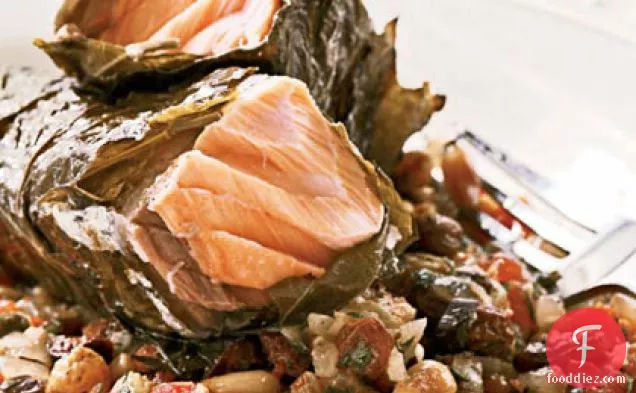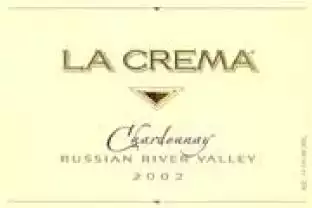Grilled Salmon in Grape Leaves with Tomato-Raisin Relish

Grilled Salmon in Grape Leaves with Tomato-Raisin Relish might be just the main course you are searching for. One portion of this dish contains approximately 36g of protein, 25g of fat, and a total of 406 calories. This gluten free, dairy free, and primal recipe serves 4. The Fourth Of July will be even more special with this recipe. If you have salt, tomato-raisin relish, olive oil, and a few other ingredients on hand, you can make it. To use up the olive oil you could follow this main course with the Sauteed Banana, Granolan and Yogurt Parfait as a dessert. From preparation to the plate, this recipe takes roughly 45 minutes.
Instructions
1
Sprinkle salmon fillets evenly with salt and pepper; set aside.
Ingredients you will need![Salt And Pepper]() Salt And Pepper
Salt And Pepper![Salmon Fillets]() Salmon Fillets
Salmon Fillets
4
Place one salmon fillet, skin-side down, in center of leaves. Fold grape leaves up and over salmon, patting down gently to seal as much as possible.
Ingredients you will need![Salmon]() Salmon
Salmon![Grape Leaves]() Grape Leaves
Grape Leaves
5
Brush leaves with olive oil to help seal edges. Repeat with remaining salmon and grape leaves.
Ingredients you will need![Grape Leaves]() Grape Leaves
Grape Leaves![Olive Oil]() Olive Oil
Olive Oil![Salmon]() Salmon
Salmon
Equipment
Ingredients
Recommended wine: Chardonnay, Pinot Noir, Sauvignon Blanc
Salmon works really well with Chardonnay, Pinot Noir, and Sauvignon Blanc. To decide on white or red, you should consider your seasoning and sauces. Chardonnay is a great friend to buttery, creamy dishes, while sauvignon blanc can complement herb or citrus-centric dishes. A light-bodied, low-tannin red such as the pinot noir goes great with broiled or grilled salmon. One wine you could try is La Crema Russian River Chardonnay. It has 4.1 out of 5 stars and a bottle costs about 28 dollars.

La Crema Russian River Chardonnay
On the nose are citrus tones, with green apple, pineapple and floral aromas accentuated by caramel and hazelnut traces. The bright fruit and crisp acidity typical of the Russian River appellation are apparent in the mouth, with lemon-lime components and concentrated pear notes, offset by a lingering apple and spice finish.DifficultyMedium
Ready In45 m.
Servings4
Health Score100
Occasions4th Of JulySummer
Related recipes
Warm Szechuan Shrimp and Spinach Salad
Simple Seafood Alfredo
Tasty Tuna Casserole
Grilled Lobster and Avocado Cocktail
Magazine

Your Inner Chef with Taylor Swift's Top 3 Recipes from Her Beloved NYC Hangout

20 Mouthwatering Recipes You Need to Try Today!

Master the Art of Making Perfect Pancakes with This Foolproof Recipe

The Science Behind Red Wine: Its Surprising Health Benefits and Potential Risks

12 Wine Cocktails for a Sophisticated Twist

Sip, Swirl, and Celebrate: Toasting to National Wine Day on May 25th

National Drink Wine Day on February 18

Celebrating Souffle Day with Delectable Delights

Indulge in the Delightful Flavor of Oyster Soup on Its Special Day!

Celebrating World Nutella Day

Exploring the Delights of Authentic French Pastries

Discover the Flavors of Eastern Europe

Predicted Food Trends for 2023 and Beyond

Exciting Christmas Recipes to Try for the Ultimate Holiday Feast in 2023

Street Food Revolution

Uncover the Secrets of Lip-Smacking Recipes for Outdoor Cooking

Unveiling the Science Behind Cultured Meat

Our Ultimate Recipes Guide for 2023-2024

Australian Cuisine Exploring the Flavors Down Under

From Asado to Empanadas Food Culture Argentina

Your Inner Chef with Taylor Swift's Top 3 Recipes from Her Beloved NYC Hangout

20 Mouthwatering Recipes You Need to Try Today!

12 Wine Cocktails for a Sophisticated Twist

Sip, Swirl, and Celebrate: Toasting to National Wine Day on May 25th

National Drink Wine Day on February 18

Indulge in the Delightful Flavor of Oyster Soup on Its Special Day!

These Super Recipes for Your Football Party!

The Secrets Behind 3 Classic Comfort Food Recipes

Recipes to Spice Up Your February Menu







